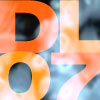(JB) There were several films on Monday's programme which I would place in the venerable genre of the cinematic essay. As other interesting artistic genres, the cinematic essay evades a proper definition, and usually includes films that somehow have stepped outside one of the more concise genre definitions, e.g. the documentary, the narrative film or the formal experiment. The first of yesterday's films I'd like to mention in this context is “Sag nicht, es sei dunkel” (2007) by Sebastian Bodirsky, filmed in Belgrade in 2006-2007.  Sebastian Bodirsky DE Sag nicht, es sei dunkel, 27min, 2007
Sebastian Bodirsky DE Sag nicht, es sei dunkel, 27min, 2007
As you can see looking at some other of his works, Bodirsky seems interested in both a very formal approach to the images and shapes we encounter in everyday life, and the socio-political issues which might be connected to these – often seemingly arbitrary – designs & constructions. In “Sag nicht ...”, he picks out small urban details like weirdly overlapping steps or pavings, street signs and other kinds of environmental (mis-)information; the depicted city seems like the result of a kind of crash between several other places, which then settled on an uneasy and rugged co-existence (so, there are clipping issues outside of Second Life, too). Of course – as this is Belgrade – this “crash” is far from being metaphoric. It usually makes me feel queasy when artists from affluent societies take a highly aesthetic look at life and living in other countries, as this often results in a kind of well-meant & paternalist exoticism of the poor or “different”. Bodirsky evades this trap be inserting three scenes, in which the detached impressions are suddenly disrupted by one of the “bystanders” suddenly addressing the author/viewer directly, and stating some poetically phrased, not-so-fun facts about life in former Yugoslavia and today's Serbia; the questionable viewpoint of the voyeuristic author and audience, until then revelling in the aesthetic qualities of the mutilated and chimeric cityscape, suddenly is inverted and turned against itself.
Masha Godovannaya's “objects in mirror are closer than they appear” (2007), shown later as a special feature, had a analogous, but very different redeeming moment. Godovannaya, born in Moscow and now living in St. Petersburg, had spent some time in NY, where she also shot most of the footage for the full-feature “objects ...”. Unlike Bodirsky, whose every take resembles a carefully arranged composition (it seems as if he had meticulously taken down the ideal coordinates for the most perfect picture, even during panning – he should be a good contender for a future Michael Mann movie's cinematography), Godovannaya employs a shaky hand camera, seemingly random and spontaneous takes and impressions of her surroundings. This isn't a tourist's NYC, either; most of the footage is shot in or around the poorer parts of Brooklyn, often from a car or, presumably, out of Godovannaya's or a friend's flat's window. Equally, the soundtrack is a fairly non-linear collage of field recordings; in many cases, it is difficult to distinguish which one of the samples – if any, that is – might be the actual ambient sound of the video footage itself. While the material used by Godovannaya – arbitrary as it might seem at a first glance – retains a highly documentary feel, the montage transforms it into a kind of condensed retrospective meditation, in which every image and sound is just a catalyst for other impressions. Like Bodirsky, Godovannaya is neither a native nor a simple passer-by ticking off the most obvious landmarks; her journey through NYC seems to be a re-tracing of her own search for an adequate impression, most likely an impression not conveying only a authentic “NY moment” but also the artist's own self-reflection as a foreign visitor. To me, the most crucial moment seemed a scene shot during an art fair, in or beside the booth of – of all people – highly commercial NY gallery owner Dave Zwirner; the only scene I recall which actually took place in a “professional” environment, and not on the streets, some means of transport or a private space. With a crash, we suddenly remember that – after the slightly romantic, slightly depressing accounts of NY life shown before – Masha Godovannaya is actually a professional artist and thus part of the same – commercial – art scene as Zwirner, and we, the art crowd, are watching a product of this scene right now, in the very centre of Berlin, not far from the Auguststraße and with the glittery world of the Berlinale a couple of miles further down. This is, somehow, even more romantic, and even more depressing, too.
I might write something on a couple of other flims from Monday's programme tomorrow, right now I'm off for this evening's show -
Bye, JB



 Spree Getraenke
Spree Getraenke











0 Comments:
Post a Comment